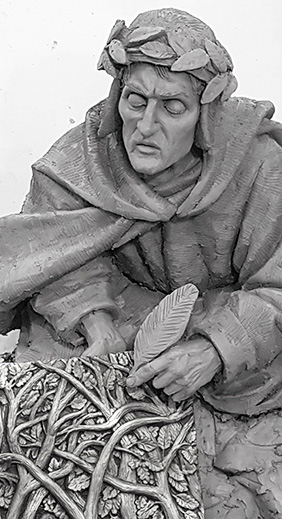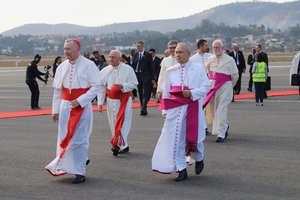Celebrate Dante and Help Fight the Coronavirus
New sculptures and a new translation bring Dante’s Divine Comedy to life.


In Italy, March 25 was the first official “Dante Day” — a day dedicated by the Italian government to celebrate the accomplishments of the Florentine poet who penned the long narrative poem titled The Divine Comedy. On that day, Schmalz introduced a new set of sculptures through an online book which will include a series of 100 sculptures, representing all 100 cantos in the Divine Comedy. Modern readers have found the existing translations of the Divine Comedy from the original Italian, including one translation by Henry Wadsworth Longfellow, somewhat cumbersome — so Schmalz is partnering with translator Daniel Fitzpatrick, who is working to produce an easy-to-read version that will appeal to a wide audience.
Tim Schmalz spoke recently about the ambitious project. “I’ve been working on this for the last year,” he explained. “I thought I'd do what hasn't been done in 700 years — create sculptures depicting scenes from all 100 of Dante’s cantos.” The book, he hoped, would be a celebration of Catholicism — he believed Dante’s book, with its imaginative vision of the afterlife, to be one of the world’s most important Catholic literary treasures. Many readers, Schmalz reported, focus on the first portion of the book, which leads the reader through the levels of Hell (the Inferno). Schmalz hoped that the illustrations of his sculptures would lead the reader to go beyond the Inferno, to learn about Dante’s depictions of Purgatory (the Purgatorio) and finally, Heaven (the Paradisio).
The COVID-19 Crisis, and a New Plan to Help
Schmalz had originally intended for the book’s initial release to be in hardcover March 25, 2021, when the nation of Italy will celebrate the 700th anniversary of Dante’s death. That plan changed, however, when Schmalz became aware of the scope of the tragedy emerging in Italy due to the novel coronavirus. “As I was coming to my studio early last Friday,” Schmalz told the Register, “I was listening to the news about the horrors and the tragedy that’s happening in Italy. I thought, ‘Isn’t it ironic? Here I am, creating this greatest hero of Italy, while Italy is going through such a horrible situation!’ Then I put the two things together: I could use the book to help Italy!”
Daniel Fitzpatrick, the translator, agreed, and plans were made to release the book of poetry and art in a series format, and to donate all proceeds from sales of the e-book to help the hospitals of Italy better care for their critically ill patients. For a donation of just $5, readers can sign up to receive two cantos each week — one on Wednesday and the second on Sunday — beginning with Dante’s first vision of the Inferno, and culminating in the Paradisio, in time for Italy’s 700th anniversary celebration.
Schmalz cited two reasons for releasing the book in segments. First, he explained, he hoped that readers who receive two segments each week will remain interested, and will not be overwhelmed by the lengthy text. Each segment will begin with an image of one of Schmalz’s sculptures, which will lead readers into the newly translated story.
But the second reason, he admitted, was that they’re not finished! Both the sculptor and the translator were working to produce a printed book before March 2021 — so they’ll be finishing their work, even as readers begin reading the first chapter. The detailed sculptures and the rich text will recount Dante’s tale of struggle, about endurance, about God and faith. This is something, Schmalz believes, that people can really benefit from during this time of stress, as individuals are practicing social-distancing. Schmalz noted a poetic parallel: Just as people today will find gradual release from the constraints imposed by COVID-19, Dante in his seminal work spiraled upward, breaking free from the Inferno and climbing gradually upward toward freedom, until he finally found solace in Heaven.
Italians and all people today, Schmalz says, are living in social isolation to avoid spread of the disease, and often they’re distracting themselves with video games, Netflix and other unimportant pursuits. This is a great opportunity to instead use the time to become acquainted with this great work of Catholic literature, through the medium of art and a new translation.
Dante’s Divine Comedy is published by En Route Books and Media, a new Catholic publishing house launched in 2014. To read the first chapter and to sign up for future chapters of The Divine Comedy, sign up to “Help Dante Help Italy.” Make a donation of at least $5 through the GoFundMe page, and you'll be added to the email list to receive semiweekly installments.
- Keywords:
- coronavirus
- dante

















